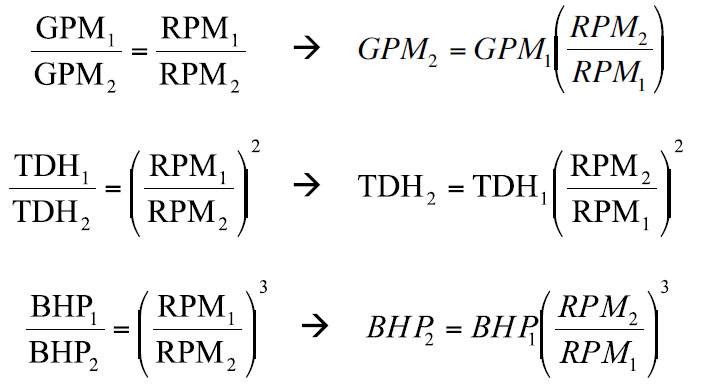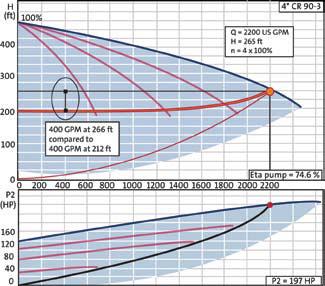Packaged pump systems are gaining popularity due to their space saving design, simplified installation, single source responsibility and advanced control options with communication ability.
Packaged means that all the components needed for the pump system are wired, piped and mounted on a base. This compact configuration offers easy installation.
Variable Flow Requirements
Domestic water supply systems have variable flow demands and can save energy with variable frequency drive (VFD) controlled pumps. There is an opportunity with existing pump installations to discover the true state of the system by performing a pump audit. A pump audit determines the consumption flow profile and energy usage that the installation experiences during normal operation. Acquiring a flow profile for an existing system provides the precise data required to design the optimum system for the application. A system designed with pump audit data will lead to a highly efficient system design with lower cost of ownership.
New installations typically use plumbing fixture counts and the Hunter's Curve for sizing the pump system as recommended or required by inspectors or local codes. This method can lead to oversized pumps or pump systems, and does not address the variable flow requirement for the domestic water supply.

Figure 1. Typical domestic water consumption flow profile for a small commercial building
The flow profile in Figure 1 indicates that the demand increases in the morning and in the afternoon to the maximum flow, and gradually drops off and stops in the night hours. Peak flow is required for three hours of the day. The flow is mostly less than 50 percent of peak flow. In this example, a pump system with two 50 percent pumps would match the flow profile compared to a single 100 percent pump, and would ensure that the system operates near peak efficiency. One 100 percent pump would run near peak efficiency for less than half of the time. This example shows relatively small flow requirements, but the same holds true for larger flows where even more energy can be saved.
VFD-Controlled Pumps
The Affinity Laws state how a pump's performance changes with changing pump speed (RPM).

Small reductions in pump speed can create large reductions in brake horsepower (BHP). The brake BHP changes by factor of the cube of the speed change ratio.
Figures 2 to 4 show an example of a constant pressure application with two different flow rates that compares a VFD-controlled pump to a fixed speed pump with a pressure regulating valve. In this application, 116 ft constant pressure is required at 180 gpm and 90 gpm.

Figure 2
Figure 3 demonstrates that the pump requires 3.77 hp at 85 percent speed using VFD control to achieve 90

Figure 3

Figure 4
Figure 4 illustrates a curve for a constant speed pump and a pressure regulating valve (PRV) to maintain the required pressure (116 ft). This system builds 167 ft of pressure at 90 gpm and uses 5.7 bhp. The PRV reduces the extra pressure. However, the PRV wastes energy and requires periodic maintenance. This can be eliminated with VFD-controlled pumps.
If the reduced operating condition was required for 50 percent of the time and operated 24/7, using a VFD system saves $750 in energy cost compared to a PRV system. The calculation is based on a $0.10 kWh energy cost and 85 percent VFD and motor efficiency. A system with relatively low speed reduction (15 percent) saves significant energy.
VFD-controlled systems allow for precise control of the discharge pressure and have other advantages including:
- Flexibility to electronically "trim" pump(s) when oversized
- Soft starting of motors (no motor cycling issues)
- Smooth and controlled performance ramp up and down (less mechanical problems/maintenance)
- System turns off itself at low or no flow (additional energy savings)
Choosing the Right Pump(s)
Pump selection for variable flow applications is different than choosing a pump for a single duty point. A single duty point application requires the selection of a pump at the best efficiency point (BEP). Pumps have the highest life expectancy when they are run near BEP. Variable flow applications require multiple duty points.
Selecting pumps for variable flow service requires the following considerations:
- NPSH available
- Possibility of over or undersized system
- Pump type-single or multiple impeller
Rule of thumb for selecting pumps for variable flow service is to select a pump at the right of the BEP. Selecting a pump to the right of BEP will allow the pump(s) to stay in the best efficiency range at the lower flow demands.
The downside for selecting a pump to the right of BEP is increased NPSH requirement. In some cases, due to NPSHA, a pump selection at the right of BEP may not be suitable.
Pump type is another consideration. Single impeller pumps typically have a flatter curve compared to multiple impeller pumps and are less forgiving in situations where conditions change and the pumps are undersized. An oversized pump with VFD control can be electronically "trimmed" by speed reduction. The steeper curve of a multiple impeller pump allows for more speed reduction ratio at lower flows, increases the pump's flexibility to meet a changing design pressure requirement and allows higher energy savings. Multistage pumps, by design, are more service-friendly than single impeller end suction pumps. The multistage pump, together with VFD control, is an ideal choice for variable flow pressure boosting.
Proportional Pressure Control
Municipal domestic water pump systems have a high head requirement dedicated to pipe friction loss. Pipe friction loss compensation via proportional pressure control provides significant savings and reduces problems associated with high pressure, which can occur when flow rates are low compared to the design conditions.
Pump systems are typically oversized due to a conservative head loss calculation and additional safety margins. Municipal pump systems with large pipe networks are often oversized intentionally to prepare for future growth. The head required for the pump system includes the pipe friction head based on future high flow design conditions. This can result in a large pump system that has the possibility of using more energy than it should.
Figure 5 shows a four-pump system with a maximum design condition of 2,200 gpm at 266 ft boost. If the design pipe friction loss of the system is 20 percent of the total required boost pressure (266 ft), the actual pressure boost requirement at 400 gpm is 212 ft.

Figure 5
Proportional pressure control decreases pressure at lower flows and increases it at higher flows to compensate for pipe friction loss.
If the pump system operates 24/7 at 400 gpm for 50 percent of the time at a rate of $0.10/kWh, the result is an annual savings of $2,592, based on an overall motor/VFD efficiency of 88 percent. In addition to energy savings, proportional pressure control reduces leaks and saves water at low flow periods by reducing the system pressure.
Choosing the Right System
VFD-controlled pump systems offer pressure control with energy savings and the ability to match the flow consumption profile without waste. Systems with multiple pumps deliver variable flow requirements at BEP range. It is important to identify the flow consumption profile of the installation. If the flow rate is constant, a single service duty pump might be the solution. Even for these applications, VFD-controlled pump systems may be justified with reduced maintenance costs.
Case Study
Owners of the Mani Brothers 14-story commercial office building in West Hollywood, Calif., were having problems with their potable water booster pumps. The system was in poor condition and did not provide adequate water pressure on the upper floors of the building. The capacity of the system was not known because the nameplates had been removed and the original engineering documents were not available. The triplex system included one 5 hp pump and two 10 hp pumps (25 hp connected). Each pump was equipped with a PRV, and the system controls were inefficient.
Based on the data found in the audit, an optimized system with the lowest possible life cycle cost was selected and submitted with the complete audit report.

- Flow readings logged every 60 seconds
- Peak flows created by cooling tower demands which last 1-2 minutes/hr
- Workday: 7 a.m. - 7 p.m. (37 percent of annual hours)
- Non-workday flows are much lower-averaging approximately 5 to 8 gpm
Load Profile of Total Flow for One Week:

The four pump replacement booster system (3 hp each pump-12 HP connected) is equipped with variable speed frequency drive. The maximum flow can be handled by three pumps, with the fourth pump serving as an "online backup."
The annual cost of energy to operate the old system is estimated to be $10,000, with an additional $2,000 in annual maintenance and repair costs. The annual cost of energy to operate the replacement system is approximately $1,800, a savings of an estimated $8,200. Additionally, the retrofit offers eligibility for a $5,400 rebate from Southern California Edison.
Pumps and Systems, July 2010


